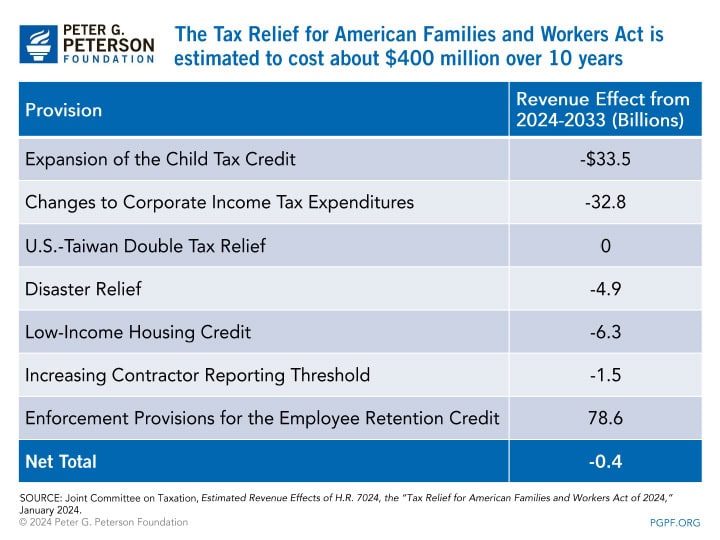How Would the Tax Relief for American Families and Workers Act Change Federal Tax Law?
On January 16, a bipartisan group of lawmakers in both the House and Senate unveiled the proposed Tax Relief for American Families and Workers Act. Most notably, the bill would temporarily enhance the Child Tax Credit (CTC) and temporarily restore various business tax provisions. The cost of the legislation would be largely offset through enforcement provisions to the Employee Retention Tax Credit (ERTC). The package is still being negotiated, but the provisions that were originally included and their estimated 10-year cost are shown in the table below. Revenue loss from the bill would be larger if the provisions were to be made permanent.

Expanding the Child Tax Credit
The CTC is a provision of the tax code intended to ease the financial burden faced by families. In response to the COVID-19 pandemic, policymakers temporarily enhanced the credit as part of the American Rescue Plan in 2021. Those enhancements have since expired; the current legislation would make more modest changes.
The legislation would make the following adjustments to the CTC:
- Index the credit, which is currently capped at $2,000, to inflation for tax years 2024 and 2025.
- Gradually adjust the refundable portion of the credit, which is the amount taxpayers can receive as payment if the credit exceeds their tax liability, from its current level of $1,600 to $1,800 in 2023, $1,900 in 2024, and $2,000 in 2025.
- Allow taxpayers to use their earned income from the prior taxable year to calculate their CTC in 2024 and 2025 if their earned income was more than in the current year.
Expanding the CTC would cost $33.5 billion between 2024 and 2026, according to the Joint Committee on Taxation (JCT).
Changes to Corporate Income Tax Expenditures
The legislation would change tax rules for some corporate tax expenditures previously addressed in the Tax Cuts and Jobs Act of 2017 (TCJA). Four provisions would be modified by the bill:
- Bonus depreciation: The TCJA allowed businesses to deduct 100 percent of the cost of qualified property (e.g., machinery or equipment) in the first taxable year of use from 2018 through 2022. The proposed bill would extend this provision through 2025.
- Credit for increasing research activities: Currently, businesses can deduct the cost of research and experimentation, but those costs must be deducted over a five-year period if incurred after 2021. The bill would delay the five-year requirement from going into effect until 2026, meaning businesses could deduct 100 percent of research expenses in the tax year they are incurred through 2025.
- Limitation on business interest deduction: Business interest deductions are capped at 30 percent of adjusted taxable income (ATI). Starting in 2022, ATI was determined by earnings before interest and taxes, thus restricting the possible size of the deduction. The proposed bill would change the calculation of ATI to earnings before interest, taxes, depreciation, and amortization from 2024 and 2025, which would increase the interest deduction for most businesses.
- Depreciable business assets: The legislation would increase the amount that taxpayers could expense for the cost of qualifying property from $1.16 million to $1.29 million in 2023.
The corporate tax provisions would reduce revenues by $32.8 billion between 2024 and 2033, according to JCT.
New Tax Enforcement for the Employee Retention Credit
As part of the response to the COVID-19 pandemic, lawmakers enacted the ERTC, which was intended to offset the cost to businesses of paying workers during the economic downturn and closures caused by the pandemic. Currently, taxpayers can claim the ERTC until April 15, 2025 for payments made after March 12, 2020 and before January 1, 2022. The bill would bring forward the deadline for claims to January 31, 2024. The bill would also enhance penalties for fraud related to the ERTC and extend the statute of limitations by one year.
Other Provisions of the Legislation
Other provisions of the bill include:
- Taiwan double taxation relief: The provision would amend the U.S. tax code to provide tax relief for businesses and workers operating in both Taiwan and the United States. It would also authorize the President to negotiate and enter into a tax agreement with Taiwan that is similar to existing tax treaties.
- Disaster relief: The bill would extend the Taxpayer Certainty and Disaster Tax Relief Act of 2020 — which created a deduction for disaster-related personal casualty losses — to the date of the enactment of the bill. It would also temporarily exclude disaster relief payments for certain wildfires and the East Palestine, Ohio train derailment from the calculation of gross income for federal tax purposes.
- Low-Income Housing Tax Credit: To encourage developers to build more affordable housing, the bill would increase the credit from around 9 percent of the cost to 12.5 percent through 2025, thereby allowing states to allocate more credits. If a building does not receive a credit allocation from a state, a developer can still receive a 4 percent federal tax credit if they meet the financing threshold for certain qualifying bonds. The provision would lower that threshold from 50 percent to 30 percent.
- Increase threshold for contractor payment reporting: The final provision would ease reporting requirements for businesses who make payments to other persons. Currently, businesses must report payments to contractors exceeding $600 over the taxable year. Starting in 2024, the new reporting threshold would be set to $1,000 in payments over a calendar year and indexed for inflation.
Potential Additional Costs
All told, the temporary provisions in this legislation would be fully paid for through the early termination and additional enforcement of the ERTC. However, if the CTC, corporate tax, and other provisions were made permanent, the Committee for a Responsible Federal Budget estimates that they could reduce revenues by $645 billion over the decade. With America’s fiscal outlook on a dangerously unsustainable path, it is critically important that lawmakers fully pay for their priorities.
Image credit: Getty Images/Phillip Faraone
Further Reading
Should We Eliminate the Social Security Tax Cap?
There have been a number of proposals to increase, eliminate, or otherwise adjust the payroll tax cap as a way to shore up Social Security’s finances.
No Taxes on Tips Will Drive Deficits Higher
Here’s how this new, temporary deduction will affect federal revenues, budget deficits, and tax equity.
Three Reasons Why Assuming Sustained 3% Growth is a Budget Gimmick
GDP growth of 3 percent is significantly higher than independent, nonpartisan estimates and historically difficult to achieve.


